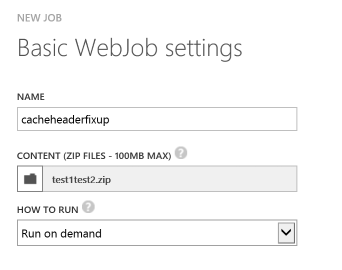Here's an updated version of the previous answer:
Instead of creating a website and using a WorkerRole, Azure now has the ability to run "WebJobs". You can run any executable on demand on a website at the same datacenter where your storage account is located to set cache headers or any other header field.
- Create a throw-away, temporary website in the same datacenter as your storage account. Don't worry about affinity groups; create an empty ASP.NET site or any other simple site. The content is unimportant.
- Create a console program using the code below which works with the updated Azure Storage APIs. Compile it for release, and then zip the executable and all required DLLs into a .zip file.
- Create a WebJob and upload the .zip file from step #2.

4. Run the WebJob. Everything written to the console is available to view in the log file created and accessible from the WebJob control page.
5. Note the UpdateAzureServiceVersion method. Apparently, by default, Azure storage serves improperly formatted ETags so you may wish to run this code once, for details see: this
The code below runs a separate task for each container, and I'm getting about 70 headers updated per second per container. No egress charges.
using Microsoft.WindowsAzure.Storage;
using Microsoft.WindowsAzure.Storage.Auth;
using Microsoft.WindowsAzure.Storage.Blob;
namespace AzureHeaders
{
class Program
{
static StorageCredentials storageCredentials =
new StorageCredentials("azureaccountname", @"azzureaccountkey");
private static string newCacheSettings = "public, max-age=7776000"; // 3 months
private static string[] containersToProcess = { "container1", "container2" };
static void Main(string[] args)
{
var account = new CloudStorageAccount(
storageCredentials,
false /* useHttps */);
CloudBlobClient blobClient = account.CreateCloudBlobClient();
var tasks = new List<Task>();
foreach (var container in blobClient.ListContainers())
{
if (containersToProcess.Contains(container.Name))
{
var c = container;
tasks.Add(Task.Run(() => FixHeaders(c)));
}
}
Task.WaitAll(tasks.ToArray());
}
private static async Task FixHeaders(CloudBlobContainer cloudBlobContainer)
{
int totalCount = 0, updateCount = 0, errorCount = 0;
Console.WriteLine("Starting container: " + cloudBlobContainer.Name);
IEnumerable<IListBlobItem> blobInfos = cloudBlobContainer.ListBlobs(useFlatBlobListing: true);
foreach (var blobInfo in blobInfos)
{
try
{
CloudBlockBlob blockBlob = (CloudBlockBlob)blobInfo;
var blob = await cloudBlobContainer.GetBlobReferenceFromServerAsync(blockBlob.Name);
blob.FetchAttributes();
// set cache-control header if necessary
if (blob.Properties.CacheControl != newCacheSettings)
{
blob.Properties.CacheControl = newCacheSettings;
blob.SetProperties();
updateCount++;
}
}
catch (Exception ex)
{
// Console.WriteLine(ex.Message);
errorCount++;
}
totalCount++;
}
Console.WriteLine("Finished container: " + cloudBlobContainer.Name +
", TotalCount = " + totalCount +
", Updated = " + updateCount +
", Errors = " + errorCount);
}
// http://geekswithblogs.net/EltonStoneman/archive/2014/10/09/configure-azure-storage-to-return-proper-response-headers-for-blob.aspx
private static void UpdateAzureServiceVersion(CloudBlobClient blobClient)
{
var props = blobClient.GetServiceProperties();
props.DefaultServiceVersion = "2014-02-14";
blobClient.SetServiceProperties(props);
}
}
}
 REGISTER FOR FREE WEBINAR
X
REGISTER FOR FREE WEBINAR
X
 Thank you for registering
Join Edureka Meetup community for 100+ Free Webinars each month
JOIN MEETUP GROUP
Thank you for registering
Join Edureka Meetup community for 100+ Free Webinars each month
JOIN MEETUP GROUP